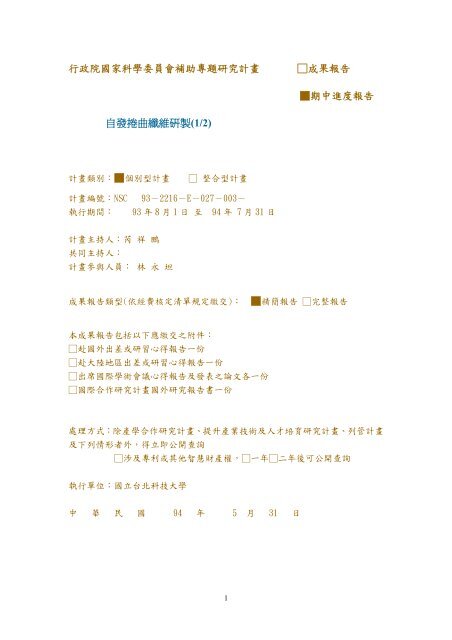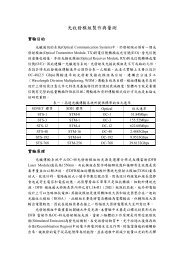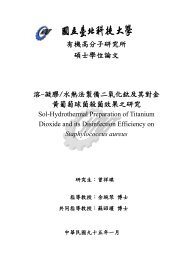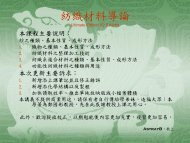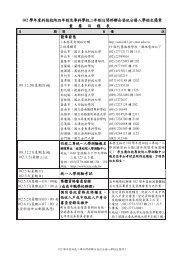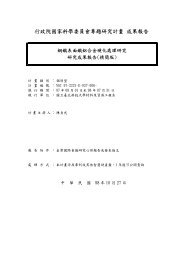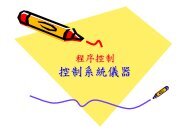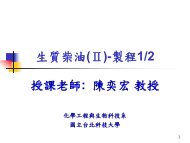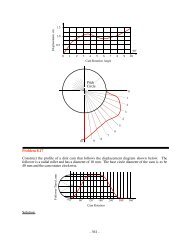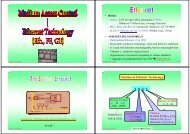è¡æ¿é¢å家ç§å¸å§å¡æè£å©å°é¡ç 究è¨ç« ææå ±å æä¸é²åº¦å ±å èªç¼ ...
è¡æ¿é¢å家ç§å¸å§å¡æè£å©å°é¡ç 究è¨ç« ææå ±å æä¸é²åº¦å ±å èªç¼ ...
è¡æ¿é¢å家ç§å¸å§å¡æè£å©å°é¡ç 究è¨ç« ææå ±å æä¸é²åº¦å ±å èªç¼ ...
Create successful ePaper yourself
Turn your PDF publications into a flip-book with our unique Google optimized e-Paper software.
行 政 院 國 家 科 學 委 員 會 補 助 專 題 研 究 計 畫□ 成 果 報 告■ 期 中 進 度 報 告自 發 捲 曲 纖 維 研 製 (1/2)計 畫 類 別 :■ 個 別 型 計 畫□ 整 合 型 計 畫計 畫 編 號 :NSC執 行 期 間 :93-2216-E-027-003-93 年 8 月 1 日 至 94 年 7 月 31 日計 畫 主 持 人 : 芮 祥 鵬共 同 主 持 人 :計 畫 參 與 人 員 : 林 永 坦成 果 報 告 類 型 ( 依 經 費 核 定 清 單 規 定 繳 交 ): ■ 精 簡 報 告 □ 完 整 報 告本 成 果 報 告 包 括 以 下 應 繳 交 之 附 件 :□ 赴 國 外 出 差 或 研 習 心 得 報 告 一 份□ 赴 大 陸 地 區 出 差 或 研 習 心 得 報 告 一 份□ 出 席 國 際 學 術 會 議 心 得 報 告 及 發 表 之 論 文 各 一 份□ 國 際 合 作 研 究 計 畫 國 外 研 究 報 告 書 一 份處 理 方 式 : 除 產 學 合 作 研 究 計 畫 、 提 升 產 業 技 術 及 人 才 培 育 研 究 計 畫 、 列 管 計 畫及 下 列 情 形 者 外 , 得 立 即 公 開 查 詢□ 涉 及 專 利 或 其 他 智 慧 財 產 權 ,□ 一 年 □ 二 年 後 可 公 開 查 詢執 行 單 位 : 國 立 台 北 科 技 大 學中 華 民 國 94 年 5 月 31 日1
Study of self-crimp polyester fibersS. P. Rwei,1. Institute of Organic and Polymeric Materials,National Taipei University of Technology,Taipei, Taiwan 106, R.O.C.ABSTRACTSelf-crimp polyester yarns were manufactured using a conjugated spinning process involvingtwo parallel but attached fibers with different shrinkage properties. A theoretical model proposedby Denton was proved to be very useful for predicting crimp potential. Maintaining identical orvery similar melt viscosities of the two components was demonstrated to be very critical for obtaininga straight interface and eliminating the dog-legging problem. The crimp tests illustrate that thetriangular shapes are found to be superior to the round cross section. The optimum volume ratio formaking a self-crimp bicomponent skein is 50/50.KEYWORDS: self-crimp yarn, bicomponent fiber, thermal shrinkage, crimp potential, elastic recoveryINTRODUCTIONSelf-crimp fibers behave like naturalwool with a textured appearance. The crimpsare born from a composite of two parallel butattached fibers with differing shrinkage orexpansion properties. Since the crimp isnaturally born, the false twist or air texturinginvolved in typical fiber processing forsynthetic fibers becomes unnecessary and canbe eliminated. The elimination of this elementcan significantly cut the manufacturing costs,creating a “dream product” for asynthetic-fiber producer. Another importantcharacteristic of the self-crimp yarn is that thecrimp is not imposed on the fiber from theoutside, but rather results from therearrangement of the internal molecular structureof the fiber material. Usually the crimpgenerated by either false twist or air texturing isimposed on the fiber via mechanical deformationof the fiber as a 2-Dimensional Zig-Zag crimp(1-4). In some applications the crimped fibermust be extremely resilient, for example in fiberfilling for pillows, furniture and so on. In suchcases, a mechanical 2-D crimp is insufficient,and instead, a latent helical “self crimping” ofthe fiber is necessary.Nevertheless, spinning of conjugatedfiber represents the greatest challenge for thefiber industry (5-7). The technical difficultiesinclude: (1) the melt instability between thetwo ingredients (2) the need to instantly adjustthe throughput ratio (3) the complex design ofthe conjugated spinnerette. Du Pont Co.started to study the first self-crimp yarn (PP)during the early 1960s. Recently, the newlycommercialized self-crimp products of DuPont, polyester T-400 and nylon T-800, havebecome very popular in the market. Followingthe success of Du Pont, Unitica Co. alsocommercialized the self-crimp yarns, Z-10 andS-10. Furthermore, a nylon/polyurethanebicomponent filament, Sideria, developed byKanebo Co., can adapt heat treatment toself-crimp itself to an appropriate degree.Self-crimp yarns have apparently becomeconspicuous in the fiber industry (8-12);however, few researchers have investigatedthe crimp mechanisms and the effect offiber-processing parameters on the “crimppotential”. This study therefore attempts toproduce and elucidate a new direction forself-crimp fiber development.This study presents the results of aninvestigation on crimp formation thatconsiders several parameters, including: (1)various cross-sectional geometries such ascircles and triangles. (2) combination ofvarious polyester materials, for example PET(polyethylene terephthalate), CD (Cation2
Dyeable PET), PTT (polytrimethyleneterephthalate), and PBT (polybutyleneterephthalate), in various ratios. (3) thefiber-processing parameters (spinningtemperature, heat treatment and so on). Priorto studying the crimp, this study first examinesthe optimum rheological condition for fiberspinning. The results of this study can providefurther insight into the curling mechanism ofself-crimp yarn. Moreover, a crimp model isassessed; a method for characterizing crimp isestablished, and finally but most importantly,the optimum conditions for producing a highquality self-crimp yarn are identified.THEORETICAL REVIEWThe basic driver of self-crimping is ashrinkage differential within the fiber. Earlytheories to study the crimp mechanism werebased on mechanical models of bimetallic strips.During the early 1980s, Denton developed anadvanced equation (Eqn. 1) that used ageometrical and mechanical approach to describethis effect (13). Equation (1) has been provenpractical when applied to most fibers withregular cross-sections (Figure 1).1 / R = ( A 1 * μ 1 * △ ) / I 0 (1)where1/R denotes the crimp curvature;A 1 represents the area of either component; μ1 the first moment of A 1 , is defined as the linefrom the center of A 1 to the bulk center of thecomposite; △ denotes the fractionaldifferential shrinkage between the components,and I 0 , the second moment of area of the wholefiber cross-section, is given by summing theincrements of area times the squares of theirdistances from the axis of reference.Denton reached three importantconclusions based on Eqn. (1), as summarizedbelow:(a.) Fibers with a single interface exhibitthe best crimp potential. (b.) The crimp potentialis maximized in a skein with a straight interfacepassing through the center of the cross-sectionalarea of a conjugated fiber. (c.) The crimppotential is zero for any cross-section with acenter of symmetry (such as centric core/sheath).Eqn. (1) demonstrates that the amount ofthe differential shrinkage is the determinant ofcrimp curvature for a given cross-section.However, to obtain sufficient crimp thedifferential shrinkage must exceed a certainvalue. The differential shrinkage can be obtainedin different ways and the thermal shrinkagewithout steam was used in this work.EXPERIMENTALSpinning Setup and Fiber DrawingTwo polyester resins, comprising PET as afixed ingredient and another conjugated partselected from PBT, CD, or PTT, were spunsimultaneously using a bicomponent spinning set.PET resin with IV - 0.64 (dissolved in a solventof phenol/tetrachloroethane 6/4 at roomtemperature) and CD with IV – 0.45 weresupplied by Hsing-Kuang Ltd. PBT resin withIV - 0.9 was obtained from Chung ChunPetrochemical Ltd. PTT resin with IV – 0.95 wassupplied from Nan Ya Plastics Co. Notably, allthe resins used were bright grade except for PETresin (delustered grade with TiO 2 0.32 %) toobtain a high contrast image in analyzing thecross section of fiber. Before melt spinning, thetest polymers were dried to maintain a moisturelevel of below 100 ppm.Prior to the melt spin, the melt-viscositywas measured via a continuous rheometry(Haake Polylab System) to determine theoptimal spinning temperature. In thisinvestigation, two individual single-screwextruders extruded PET and its conjugated partseparately into the conjugated spin-pack. Thespin-pack was a side-by-side device designed byHILLS Co. Moreover, a Barmag take-up winder(BARMAG DR4) was employed for collectingthe yarns with a winding speed of 3500 m/min.A 30-minute filament package with a denier of150 den./24 fils. was gathered for eachexperimental condition.Crimp CharaterizationCalculate the crimp potential, crimpshrinkage and crimp index of each skein, usingthe following equation (14):CP = [(L 2 – L 1 ) / L 1 ] * 100 % (2)where CP denotes the crimp potential %; L 1represents the final skein length with 2.5 g load(crimped length following treatment) and L 2 isthe final skein length with 700 g load(uncrimped length after treatment).The elastic recovery test was conductedbased on the German Standard Test ProcedureDIN53835. A tensile-recovery instrument(Textechno Statimat ME, Ger.) was employedwith pretension of 0.5 cN/tex, tensile rate of 200mm/min, and recovery period of 5 minutes. Theelastic recovery (ER) was calculated accordingto Eqn. (3) shown as follows (15):ER = [(2L 0 - L 1 ) / L 0 ] * 100% (3)where L 0 denotes the initial length of skeinunder pretension; L 1 represents the final skeinlength following elongating to certain degreeand then recovering for 5 minutes.RESULTS AND DISCUSSIONMelt Spinning Stability3
The difference in viscosity between twoindividual polymers for producing abicomponent fiber can cause seriously migrateand deform the interface (16, 17). When twocomponents, with equal throughput, are extrudedusing the same spinnerette, the higher-viscositycomponent inclines to occupy over half of thecross-sectional area to equalize the pressure drop.Consequently, dog-legging, or even worse, abroken filament occurs. The search forprocessing conditions under which viscosities ofthe two components are identical or very closethus is critical to conjugated spinning, especiallyfor side-by-side products.Figures 2(a) to (d) illustrate thedependence of viscosity on shear rate forprocessing PET and CD, PBT, and PTT,respectively, at various temperatures. Theprocessing temperature of PET must be 20 to 30degrees higher than that of PTT and PBT toachieve the same melt viscosity. Notably, thistemperature difference might be offset as twopolymer merge together at the final section ofthe spinnerette. Since the residence time via themerged section is too short to even up thetemperature differences, the merged section wasassumed not to cause further viscosity difference.Figures 3 (a) to (d) show a series of PET/PBTconjugated spinning under different spinningconditions, where the spinning temperature wasmaintained at 290 o C for PET but was variedfrom 250 to 265 o C for PBT. The curvedinterface occurred in all the conditions except for3(c). This result agrees well with Figures 2 (a) (c)which illustrated a minimum difference inviscosity using the combination of PET/PBT290 o C/255 o C (Fig. 4). The curved interfaceindicates an unbalanced pressure inside thespinnerette, the low-viscosity melt was pushed tooccupy the high shear rate zone around thecapillary wall. Generally, the formation ofcrimps in a skein is more difficult for a curvedinterface than a straight interface. Moreover andmore seriously, a curved interface implies theoccurrence of a serious dog-legging problemwhich would deter and even stop the spinning.To prevent the formation of a curved interface,melt spinning for each condition here wasperformed to minimize the difference betweenthe melt viscosities of two sides via temperatureadjustment.Crimp InvestigationFigure 5 represents the effect of thecross-sectional shape on crimp potential. Theresults indicate that, in the same cross-sectionalarea, the triangular shapes are superior to theround cross section. The calculation, derivedfrom classical mechanics (18), reveals that thefirst momentμ 1 and second moment I 0 for roundshape and triangle shape are 0.405 r, 0.39 r 4 and0.483 r, 0.235 r 4 respectively. Based on Eqn. (1),the crimp curvature of triangular shape is astwice as that of round shape. This theoreticalcalculation agrees well with the experimentalresults. Furthermore, Fig. 5 demonstrates that theone in a triangular shape with higher shrinkagecomponent on the top, denoted as “the regulartriangle”, exhibits greater crimp curvature thanthe other triangle with reversed order, denoted as“the reversed triangle”.Figure 6 illustrates the influence of thevolume ratio of two components on the crimpcurvature. The optimal CP% generally occurredwith a ratio of 50/50. It can be concluded that theoptimal self-crimp can be achieved at the ratioaround 50/50 and is independent of thecombination of different components. Figure 7illustrates a series of photos of the cross sectionfor PET/PBT bicomponent fibers in variousvolume ratios. Notably, Denton predicted thatthe optimal curvature for a round yarn wouldoccur in a 50/50 combination for a straightinterface and a 60/40 combination for a curvedinterface. From Figs 6 and 7, even when bothconditions are optimized, the 50/50 with straightinterface outperformed the 60/40 with a curvedinterface. In short, both theoretical andexperimental results indicate that the ratio forcreating a self-crimp bicomponent yarn is 50/50by volume.CONCLUSIONSIn this study, self-crimp polyester yarnswere manufactured using a conjugatedspinning process. A theoretical modelproposed by Denton was proved to be veryuseful for predicting crimp potential.Maintaining identical or very similar meltviscosities of the two components wasdemonstrated to be very critical for obtaining astraight interface and eliminating thedog-legging problem. Regarding to the thermaltreatment following melt spinning, a temperaturerange approximately 20 to 30 degrees higherthan the T g of the harder side within the fiber isidentified as the optimum condition.The crimp tests illustrate that the triangularshapes are found to be superior to the roundcross section. Furthermore, a triangular shapewith higher shrinkage component on the top,denoted as “the regular triangle”, exhibits greatercrimp curvature than the other triangle withreversed order, denoted as “the reversedtriangle”. The optimum volume ratio for makinga self-crimp bicomponent skein is 50/50.4
REFERENCES1. M. Acar, H. K. Versteeg, Chem Fibers Int., 50,502-505 (2000)2. S. Biligin, H. K. Versteeg, Acar M., TextileRes. J., 66, 83-90 (1996)3. F. Bosch, Fiber Int., 49, 162-164 (1999)4. S. P. Rwei, H. I. Pai, Textile Res.J., 72,520-525 (2002)5. T. Nakajima, Advanced Fiber SpinningTechnology, Chapter 5, Woolhead Publishing,Cambridge (1994)6. H. H. Cho, K.H. Kim, Y.A. Kang, H. Ito, andT. Kikutani, J. Appl. Polym. Sci., 77, 2254(2000)7. S. P. Rwei, Z. F. Jue, F. L. Chen, Polym. Eng.Sci., 44, 331-344 (2004)8. M. Yoshitoki, M. Masahide, N. Hirotaka, JPPatent No. 2002-030527 (2002)9. S. Masayuki, M. Masahide, N. Hirotaka, JPPatent No. 2002-030527 (2002)10. K. Satoshi, S. Masayuki, M. Masahide, JPPatent No. 2001-355132 (2001)11. A. Talley, A. E. Wilkie, K. H. Buchanan, USPatent No. 6158204 (2000)12. G. A. Fernstorm, H.H. Hebeler, P.H. Lin, R.R.Moneymaker, US Patent No. 4301102 (1981)13. M. J. Denton, J. Textile Inst., 73, 253 (1982)14. G. T. C. Li, US Patent No. 4521484 (1985)15. N. Yoshihara, H. Ishihara, T. Yamada, Polym.Eng. Sci., 43, 1740 (2003)16. J. H. Southern and R. L. Ballman, J. Polym.Sci.: Polym. Phys., 13, 863 (1975)17. C. D. Han, J. Appl. Polym. Sci., 19, 1875(1975)18. J. M. Gere, Mechanics of Materials (5 thEdition), Appendix D, Thomson LearningInc., Singapore (2001)Figure 1 Side by side model employing around and a triangle cross-sectionshapesFigures 2a-d Melt viscosity as a function ofshear rate in various temperaturesfor PET (Fig. 2a), CD (Fig. 2b),PBT (Fig 2c), and PTT (Fig. 2d),respectively.5
Figure 3Photos of cross sections ofPET/PBT conjugated fibers, wherePET was spun at 290 o C while PBTwas spun at 250 (Fig.3a), 255(Fig.3b), 260 (Fig.3c), and 265 (Fig.3d)o C, respectively.Figure 6 Crimp potential as a function ofvolume fraction in a bicomponent fiberfor combinations of various polyesterswith a round crosssectional shape.Figure 4 Melt viscosity as a function of shearrate for PET and PBT at 290 o C and255 o C respectively.Figure 7 A series of photos of the crosssection for PET/PBT bicomponentfibers of various volume fractions.Fibers were spun at temperature of290 o C/255 o C, respectively.Figure 5 Crimp potential for bicomponentfibers (50/50 by volume) incombinations of various polyesterswith different cross-sectional shapes.6


